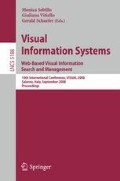Abstract
Whereas a user visually processes geographic information faster and more accurate than a computational system, a system processes a large number of geographic data much faster than a user. To minimise this large capability discrepancy, we propose a cognitively-adequate design of geovisualisation as an external aid to visual information processing. Our main objective is to release the limited cognitive workload of users by adapting the design of geovisualisations to their visual scanning capabilities. For a proof of concept, we design 2D thematic maps and 3D non-photorealistic visualisations, and evaluate the efficiency of visual scanning strategies with a computational attention-model and the eye-movement recording method.
Access this chapter
Tax calculation will be finalised at checkout
Purchases are for personal use only
Preview
Unable to display preview. Download preview PDF.
References
Hornsby, K., Egenhofer, M.: Identity-based change: a foundation for spatio-temporal knowledge representation. International Journal of Geographical Information Science 14, 207–224 (2000)
Worboys, M.F.: Event-oriented approaches to geographic phenomena. International Journal of Geographic Information Science 19, 1–28 (2005)
Gahegan, M., Takatsuka, M., Wheeler, M., Hardisty, F.: Introducing Geo-VISTA Studio: an integrated suite of visualization and computational methods for exploration and knowledge construction in geography. Computers, Environment and Urban Systems 26, 267–292 (2002)
Demšar, U.: Knowledge discovery in environmental sciences: visual and automatic data mining for radon problems in groundwater. Transactions in GIS 11, 255–281 (2007)
Coors, V., Kray, C., Elting, C., Laakso, K.: Presenting Route Instructions on Mobile Devices. In: Dykes, J., MacEachren, A., Kraak, M.-J. (eds.) Exploring Geovisualization, pp. 529–550. Elsevier, Amsterdam (2005)
Montello, D.R.: Cognitive map-design research in the twentieth century: Theoretical and Empirical Approaches. Cartography and Geographic Information Science 29, 283–304 (2002)
Chinchor, N., Hanrahan, P., Robertson, G., Rose, R.: Illuminating the path. In: Thomas, J.J., Cook, K.A. (eds.) Creating the R&D Agenda for Visual Analytics. IEEE, Los Alamitos (2005)
MacEachren, A.M., Kraak, J.M.: Research challenges in geovisualization. Cartography and Geographic Information Science 28, 3–12 (2001)
Slocum, T.A., Blok, C., Jiang, B., Koussoulakou, A., Montello, D.R., Fuhrmann, S., Nicholas, R.H.: Cognitive and Usability Issues in Geovisualization. Cartography and Geographic Information Science 28, 61–75 (2001)
Dykes, J., MacEachren, A.M., Kraak, M.-J.: Exploring Geovisualization. In Exploring Geovisualization. In: Dykes, J., MacEachren, A.M., Kraak, M.-J. (eds.) International Cartographic Association (ICA), pp. 3–19. Elsevier Oxford, Amsterdam (2005)
Nielsen, J.: Usability Engineering. Morgan Kaufmann Academic Press, London (1993)
Swienty, O., Zhang, M., Reichenbacher, T.: Attention Guiding Visualization of Geospatial Information. In: Proceedings of SPIE, Geoinformatics 2006 – Geospatial Information Technology, vol. 6421 (2006)
Reichenbacher, T., Swienty, O.: Attention-guiding geovisualisation. In: Cd-Proceedings of the 10th AGILE International Conference on Geographic Information Science (2007)
Corbetta, M., Shulman, G.L.: Control of goal-directed and stimulus-driven attention in the brain. Nature, Reviews-Neuroscience 3, 201–215 (2002)
Itti, L., Koch, C., Niebur, E.: A Model of Saliency-Based Visual Attention for Rapid Scene Analysis. Transaction on Pattern Analysis and Machine Intelligence 20, 1254–1259 (1998)
Torralba, A., Oliva, A., Castelhano, M.S., Henderson, J.M.: Contextual guidance of eye movements and attention in real-world scenes: The role of global features in object search. Psychological Review 113, 766–786 (2006)
MacEachren, A.M., Kraak, J.-M.: Exploratory Cartographic Visualization: Advancing the Agenda. Computer and Geoscience 23, 335–343 (1997)
Paas, F., Renkl, A., Sweller, J.: Cognitive load theory and instructional design: Recent developments. Educational Psychologist 38, 1–4 (2003)
Norman, D.A., Bobrow, D.G.: On data-limited and resource limited processes. Cognitive Psychology 7, 44–64 (1975)
Swienty, O., Zhang, M., Reichenbacher, T., Meng, L.: Establishing a neurocognition-based taxonomy of graphical variables for attention-guiding geovisualisation. In: Proceedings of SPIE-Geoinformatics, vol. 6751 (2007)
Reichenbacher, T.: The concept of relevance in mobile maps. In: Gartner, G., Cartwright, W., Peterson, M. (eds.) Location Based Services and TeleCartography, pp. 231–246. Springer, Heidelberg (2007)
Santella, A., de Carlo, D.: Visual Interest and NPR: an Evaluation and Manifesto. In: Proceedings of the Third International Symposium on Non-Photorealistic Animation and Rendering (NPAR), pp. 71–78 (2004)
Treisman, A., Gelade, G.: A feature integration theory of attention. Cognitive Psychology 12, 97–136 (1980)
Fabrikant, S.I., Montello, D.R., Rebich, S.: The Look of Weather Maps. In: Proceedings of the GIScience 2006, vol. 28, pp. 269–271 (2006)
Wolfe, J.M., Horowitz, T.S.: What attributes guide the deployment of visual attention and how do they do it? Nature reviews - Neuroscience 5, 1–7 (2004)
Bleisch, S., Dykes, J.: Evaluating the effectiveness of representing numeric information through abstract graphics in desktop 3D environments, Draft-Paper, From Geovisualization to geovisual analytics - Conference of ICA-Commission on Visualization and Virtual Environments, Helsinki (2007)
Author information
Authors and Affiliations
Editor information
Rights and permissions
Copyright information
© 2008 Springer-Verlag Berlin Heidelberg
About this paper
Cite this paper
Swienty, O., Jahnke, M., Kumke, H., Reppermund, S. (2008). Effective Visual Scanning of Geographic Information. In: Sebillo, M., Vitiello, G., Schaefer, G. (eds) Visual Information Systems. Web-Based Visual Information Search and Management. VISUAL 2008. Lecture Notes in Computer Science, vol 5188. Springer, Berlin, Heidelberg. https://doi.org/10.1007/978-3-540-85891-1_5
Download citation
DOI: https://doi.org/10.1007/978-3-540-85891-1_5
Publisher Name: Springer, Berlin, Heidelberg
Print ISBN: 978-3-540-85890-4
Online ISBN: 978-3-540-85891-1
eBook Packages: Computer ScienceComputer Science (R0)

